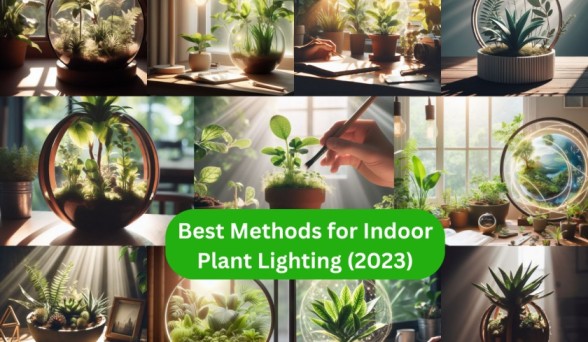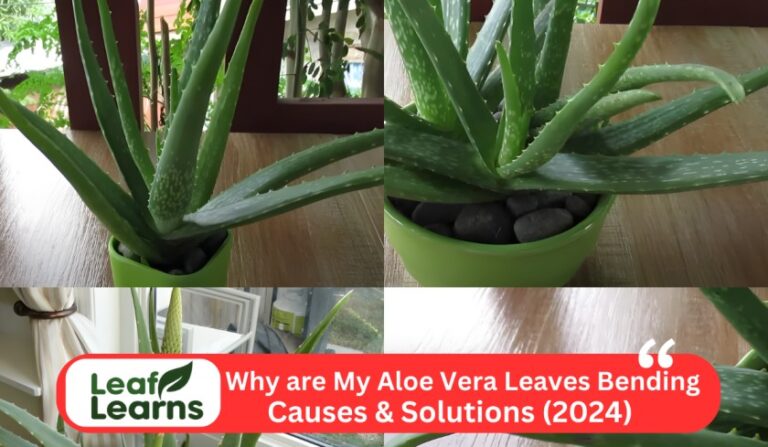Top 12 Indoor Plant Diseases: Cause, and Treatment (2023)
Indoor plant diseases can be a tough challenge for gardeners and plant growers. These diseases caused by many factors like over watering, poor ventilation, and fungal infections which can cause the yellowing leaves, wilting, and overall destroy plant health. Proper watering, humidity, Soil management and Proper temperature are key to preventing and managing indoor plant diseases.

Powdery mildew is a typical indoor plant disease that causes the leaves of infected plants to become white and powdery. High humidity and inadequate air circulation are ideal conditions for powdery mildew growth. By preventing photosynthesis and protect their general health, it can damage plants.
Indoor plants may be kept healthy by applying fungicidal treatments as needed, and also keeping proper humidity levels, and employing proper ventilation to help the plant to avoid and control this fungal disease.
| Disease | Causes | Symptoms | Treatment |
| Powdery Mildew | High humidity, poor air circulation | White powdery substance on leaves, leaf curling, reduced growth | Prune affected areas, improve air circulation, reduce humidity, fungicidal treatments, preventive measures |
| Root Rot | Overwatering, poor drainage, infected soil or plant material | Yellowing and wilting leaves, dark, slimy roots, stunted growth | Remove infected plants, prune affected roots, improve drainage, reduce watering, fungicidal treatment, preventative measures |
| Bacterial Leaf Spot | Contaminated water, poor air circulation, overcrowding | Circular spots with yellow halos, leaf yellowing and wilting | Prune affected leaves, improve air circulation, proper watering, copper-based fungicides |
| Gray Mold | Excess moisture, poor ventilation, plant injuries | Grayish fuzzy mold, necrotic spots, wilting and decay | Isolate infected plants, prune affected parts, reduce humidity, fungicidal treatment, proper spacing, proper watering |
| Plant Rust | Fungal pathogens, humid conditions, poor air circulation | Rust-colored spots, leaf yellowing, reduced vigor | Isolate infected plants, prune affected parts, fungicides, improve ventilation, maintain humidity, proper watering |
| Sooty Mold | Honeydew-producing pests, humid conditions | Black, powdery coating on leaves, reduced photosynthesis | Pest control, cleaning, improve airflow, regular maintenance, address underlying pest issues |
| Plant Viruses | Vector transmission, contaminated tools, infected plant material | Leaf mottling, stunted growth, leaf curling | Isolate infected plants, prune affected parts, pest management, quarantine, healthy environment, virus-free stock |
| White Mold | High humidity, poor air circulation, overwatering | White mycelium, yellowing and wilting, stunted growth | Isolate infected plants, reduce humidity, prune affected parts, fungicides, water management, preventative measures |
| Crown and Stem Rot | Overwatering, poor drainage, contaminated soil or material | Yellowing and wilting, dark lesions, stem discoloration | Isolate infected plants, prune affected areas, improve drainage, reduce watering, fungicides, maintain proper care practices |
| Anthracnose | Fungal pathogens, moisture, plant stress | Circular lesions, blighted foliage, fruit rot | Prune affected areas, improve air circulation, fungicidal treatment, proper watering, maintain plant health |
| Fungal Leaf Spot | Humid conditions, overhead watering, crowded planting | Circular spots of various colors, leaf yellowing, defoliation | Pruning, improved air circulation, water management, fungicides, humidity control |
| Southern Blight | Fungal pathogen, warm and humid conditions, contaminated soil | White mycelial growth, brown lesions, rapid wilt and death | Isolate affected plants, improve drainage, fungicides, remove infested soil, good sanitation, crop rotation |
Contents
- 1 Powdery Mildew
- 2 Root Rot
- 3 Bacterial Leaf Spot
- 4 Gray Mold
- 5 Plant Rust
- 6 Sooty Mold
- 7 Plant Viruses
- 8 White Mold
- 9 Crown and Stem Rot
- 10 Anthracnose
- 11 Fungal Leaf Spot
- 12 Southern Blight
- 13 Understanding and Managing Indoor Plant Diseases and Pests
- 14 Combatting Indoor Plant Pests: Identification and Remediation
- 15 Conclusion
- 16 FAQs
Powdery Mildew
Indoor plants are often infected by the fungal disease known as powdery mildew. It appears on the surfaces of leaves, stems, and even flowers as a white, powdery material.
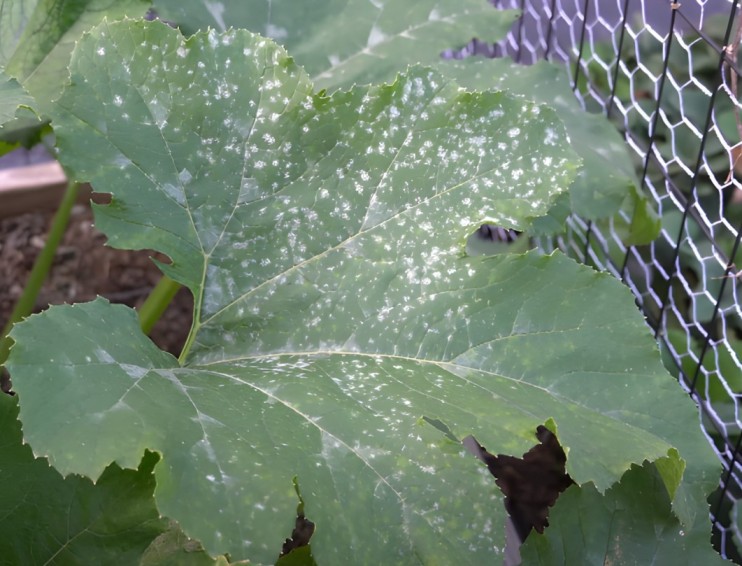
By preventing photosynthesis, this illness can damage plants, having an adverse effect on both their general health and appearance.
Causes of Powdery Mildew
High relative humidity: Powdery mildew flourishes in high relative humidity conditions.
Poor Air Circulation: This illness might develop more quickly if there is insufficient air flow around plants.
Plant species that are more prone to powdery mildew than others include the following.
Symptoms of Powdery Mildew
The development of white, powdery spots on leaves and other plant surfaces is the most obvious symptom.
Curling of the leaves: Affected leaves may curl or wilt.
Reduced Growth: Plants that are infected may have stunted growth and lose overall vigor.
Treatment of Powdery Mildew
Trim and remove diseased leaves and branches from affected areas to stop the illness from spreading.
Improve Air Circulation: Place plants far enough apart and, if required, use fans to provide healthy circulation around them.
Reduce Humidity: Keep humidity levels low by not overwatering plants and ensuring proper drainage.
Fungicidal Treatments: In severe situations, follow the manufacturer’s directions for applying a fungicide designed to control powdery mildew.
Preventive actions As powdery mildew spreads easily, quarantine new plants and examine them frequently. Additionally, wherever feasible, use plant kinds that are resistant to powdery mildew.
Root Rot
The widespread and harmful fungal disease known as root rot affects indoor plants, especially those that are cultivated in pots or containers.

This illness affects the roots of the plant, causing rotting and poor nutrient and water uptake. Root rot finally results in the death of the plant if it is not addressed.
Causes of Root Rot
Over watering: By lowering the oxygen levels surrounding the roots, excessive soil moisture fosters the growth of fungi that cause root rot.
Poor Drainage: Plant pots or other containers with inadequate drainage can collect water, which fosters the growth of fungi.
Infected Soil or Plant Material: Plants in good health may get root rot pathogens when exposed to polluted soil or plant material.
Symptoms of Root Rot
Yellowing and Wilting Leaves: Yellowing and wilting leaves are frequently the first noticeable symptoms, which are sometimes mistaken for indicators of drought stress.
Dark, Slimy Roots: As the illness worsens, infected roots become dark, mushy, and slimy to the touch.
Plants with root rot have limited development because they find it difficult to adequately absorb nutrients and water.
Treatment of Root Rot
Eliminate infected Plants: To stop the illness from spreading to healthy plants, isolate and eliminate infected plants.
Pruning Affected Roots: Use sterile pruning shears to remove sick roots, and make sure the remaining healthy roots are given the correct airflow.
Improve Drainage: To prevent waterlogging, repot the plant in soil that drains well in a container with drainage holes.
Reduce Watering: Change your watering schedule to let the soil dry out in between waterings, which will stop the spread of the fungus.
Fungicidal Treatment: If the condition is serious, you might want to use a remedy made especially for root rot. Pay close attention to the label’s directions.
Bacterial Leaf Spot
The bacterial species Pseudomonas and Xanthomonas, among others, are responsible for the widespread indoor plant disease known as bacterial leaf spot.

It predominantly affects a variety of houseplants’ leaves, reducing both their aesthetic value and general health.
Causes of bacterial leaf spot
Polluted Water: Using polluted water for irrigation can spread a disease by introducing germs to the leaves of the plant.
Poor Air Circulation: Poor air circulation can result in a humid atmosphere around plants that is perfect for the growth of germs.
Having too many plants together can restrict airflow and encourage the spread of germs among them.
Symptoms of bacterial leaf spot
Spots in a Circular Pattern: Bacterial leaf spots often appear as tiny, water-soaked dots on the leaves that are either dark brown or black.
Yellow Halos: These dots frequently have yellow haloes around them, giving them a unique look.
Leaf Yellowing and Wilting: Infected leaves may become yellow, wilt, and finally die as the disease worsens.
Also, make sure to check out our in-depth when do monstera leaves split guide.
Treatment of bacterial leaf spot
Remove and destroy the diseased leaves to stop it from spreading further by pruning the affected leaves.
Increased Air Circulation: Make sure there is appropriate space between plants and no overcrowding to promote healthy air circulation.
irrigate management: To prevent bacterial spread, irrigate plants at the base rather than the leaves. Use distilled or sterilized water.
Copper-Based Fungicides: To stop the spread of the bacterium, use copper-based fungicides as a preventative strategy or at the first indication of illness.
Gray Mold
Botrytis cinerea, sometimes referred to as grey mold, is a common fungal disease that affects a variety of indoor plants.
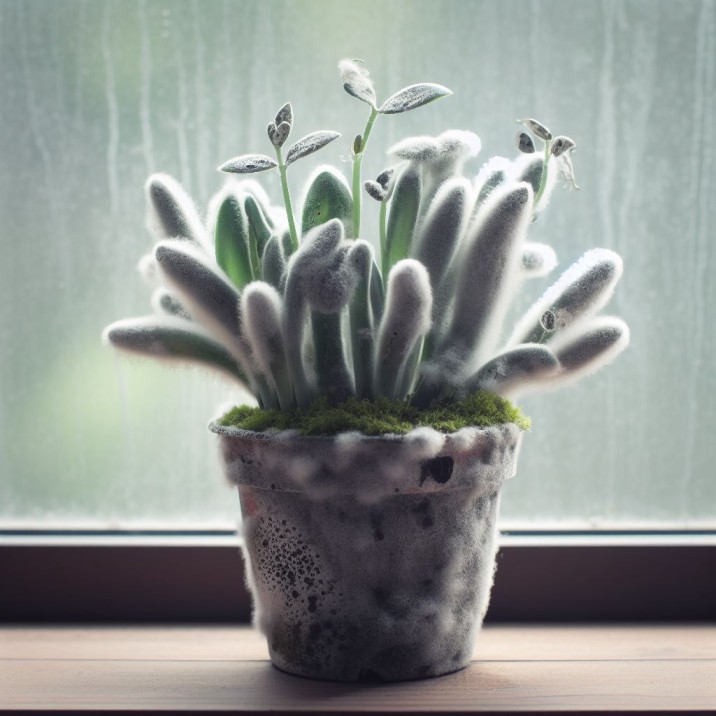
The symptoms of this illness include a fuzzy, greyish mold that develops on the leaves, stems, flowers, and even the soil surface of infected plants.
High humidity and poor air circulation are ideal conditions for grey mold growth, which makes interior spaces vulnerable to its presence.
Causes of Gray Mold
Excessive Moisture: Grey mold may grow in ideal conditions when plants are overwatered or left in moist environments.
Poor Ventilation: Insufficient airflow around indoor plants can lead to higher humidity, which fosters the development of the fungus.
Plant Injuries: The grey mold fungus can enter and spread through wounds or damage to plant tissue.
Symptoms of Gray Mold
The formation of a grey, fuzzy mold on the impacted plant parts is the most obvious indication.
Necrotic patches: Brown or black necrotic patches may appear on leaves or flowers.
Wilting and Decay: Infected plant tissues may become mushy and decompose over time, causing wilting and decay in the plant.
Treatment of Gray Mold
Plants that are afflicted should be isolated in order to stop the fungus from spreading to healthy plants.
Prune afflicted Parts: To lessen the fungal burden, remove and discard any afflicted leaves, stems, or flowers.
Reduce Humidity: By utilizing fans and avoiding overwatering, you may increase air circulation and reduce humidity levels in enclosed spaces.
Apply an appropriate fungicide labeled for the control of grey mold, following the manufacturer’s recommendations.
Avoid soaking Foliage: Water the soil directly beneath the plant instead of soaking the leaves, which can promote the growth of fungi.
Maintain Proper Plant Spacing: Ensure that there is sufficient space between indoor plants to encourage air circulation.
Plant Rust
A fungus that typically affects indoor plants is called plant rust. On the leaves, stems, or even the flowers of diseased plants, tiny, elevated, rust- or orange-colored pustules can be seen.
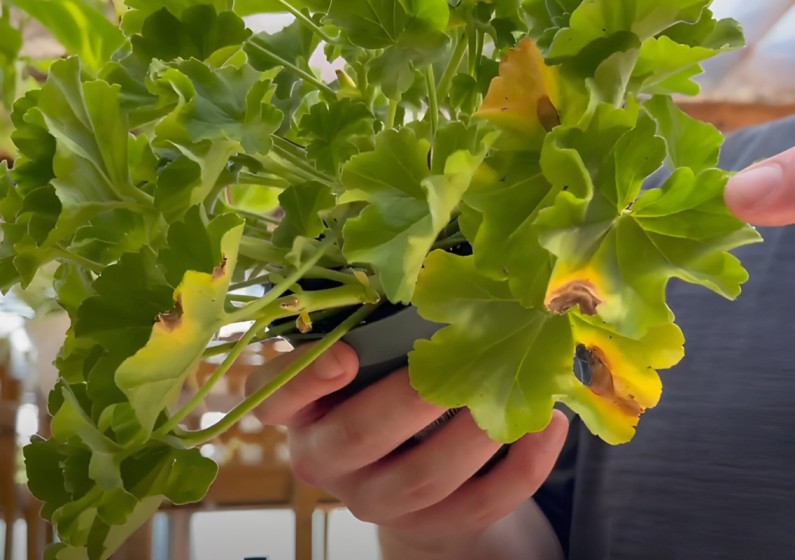
If not treated right away, this illness can weaken plants and harm their general health.
Causes of Plant Rust
Plant rust is generally brought on by a variety of fungi that are members of the Pucciniales order.
Humidity: Plant rust is more likely to form and spread when the humidity is high.
Poor Air Circulation: Rust fungus can develop more easily in environments with poor ventilation around indoor plants.
Symptoms of Plant Rust
Rust-colored Spots: On leaves, stems, and occasionally blossoms, small, elevated pustules that seem rust-colored or orange.
Leaf Yellowing: Infected leaves may become yellow and finally fall off too soon.
Reduced Plant Vigour: The disease’s nutrient loss and poor photosynthesis may cause the plant’s general health and vigor to diminish.
Treatment of Plant Rust
Isolation: To stop the illness from spreading to healthy plants, isolate diseased plants.
Pruning: To lessen the disease’s presence, prune and remove severely diseased plant sections.
Fungicides: To manage the fungal infection, use an appropriate fungicide as advised for indoor plants. Pay close attention to the directions on the product label.
Improved Ventilation: By giving the plants enough room to grow and avoiding overcrowding, you may improve air circulation around them.
Maintain Optimal Humidity: Control indoor humidity levels as they might hinder the development and spread of rust fungus.
Proper Watering: Water plants from the base up rather than drenching the leaves, as this might promote the spread of disease.
Sooty Mold
Indoor plants are susceptible to sooty mold, a common fungal disease that frequently manifests as a black, powdery covering on the leaves, stems, and occasionally even on neighboring surfaces.
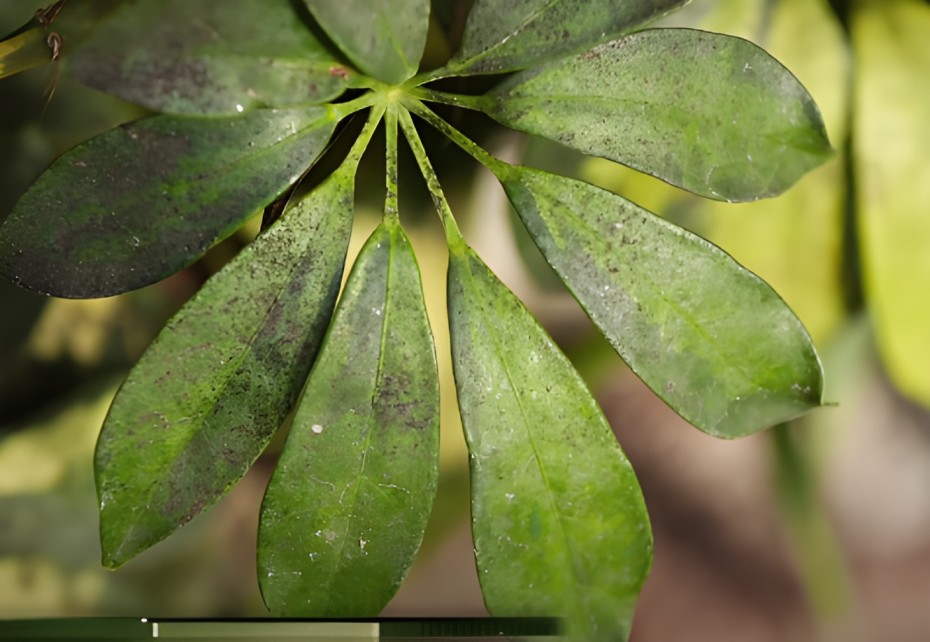
Although it doesn’t hurt the plant directly by infecting its tissues, it can have an indirect effect on the health of the plant by preventing photosynthesis and lessening the plant’s aesthetic attractiveness.
Causes of Sooty Mold
Sooty mold is frequently caused by infestations of insects that produce honeydew, such as aphids, scale insects, or mealybugs.
Residue of Honeydew: These bugs emit honeydew, a sticky material that drips onto plant surfaces. On top of the honeydew residue, sooty mold subsequently appears.
Conditions: Sooty mold is more common in enclosed places with inadequate air circulation because it thrives in humid situations.
Symptoms of Sooty Mold
The black, powdery development on leaves, stems, and surrounding surfaces is the most obvious sign.
Sooty mold can prevent photosynthesis, which can have an adverse effect on plant development and vigor.
Sooty mold can seriously reduce the visual appeal of indoor plants in addition to having a negative impact on the health of the plants.
Treatment of Sooty Mold
Use the proper pesticides or organic pest management techniques to address the underlying pest issue.
Cleaning: To get rid of the sooty mold, gently wash the afflicted plant surfaces with a solution of mild soap and water.
Enhance Airflow: To prevent the formation of sooty mold, improve airflow around indoor plants.
Regular Maintenance: Check indoor plants frequently for insect problems and deal with them right away to stop the growth of sooty mold.
Plant Viruses
Causes of Plant Viruses
Plant viruses can spread from diseased plants to healthy ones by way of insect vectors like aphids or whiteflies, which feed on the infected plants.
Equipment that has been infected: using contaminated pruning shears or gardening equipment might spread viruses when maintaining indoor plants.
Plant Material That Is Diseased: Adding diseased plants or cuttings to your indoor garden might spread viruses.
Symptoms of Plant Viruses
Leaf mottling: Infected leaves may have erratic, light, and dark green patterns that frequently resemble mottling or mosaic patterns.
Plants infected with viruses may grow slowly, have less vigor, and have smaller or deformed leaves.
Some plant viruses can cause leaves to curl or roll upward, which further detracts from the look and photosynthesis of the plant.
Treatment of Plant Viruses
To stop the virus from spreading to healthy plants, isolate affected plants.
Pruning: To lessen the viral load, remove and discard any affected plant components, such as leaves and stems.
Pest management: Use the proper tools, such as insecticidal soap or neem oil, to control insect vectors.
Before adding additional plants to your indoor garden, quarantine them to make sure they are virus-free.
Healthy Environment: To aid plants in resisting viral infections, and maintain ideal growth conditions, including the right levels of light, temperature, and humidity.
Virus-Free Stock: When adding to your collection of indoor plants, start with virus-free plant material and cuttings.
White Mold
Sclerotinia, sometimes called white mold, is a fungus that can harm indoor plants. On the damaged plant components, such as the leaves, stems, and perhaps even the flowers, fluffy, white mycelium will form.
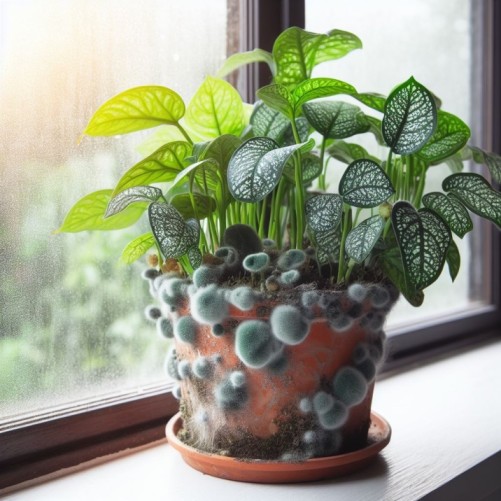
White mold may be especially troublesome since it spreads swiftly and harms the plant’s general health.
Causes of White Mold
High Humidity: White mold grows best in settings with high relative humidity, making indoor plants cultivated in excessively damp surroundings more vulnerable.
Poor Air Circulation: White mold growth can be encouraged by inadequate airflow around indoor plants.
Overwatering: Overwatering can result in soggy soil, which creates the perfect environment for white mold to colonize in the root zone.
Symptoms of White Mold
The most obvious symptom is the development of white, cottony mycelium on the surfaces of the plant.
Wilting and Yellowing: Infected leaves may wilt or die after becoming yellow.
Stunted Growth: Affected plants may show slower growth and less vigor in general.
Treatment of White Mold
Isolate diseased Plants: To stop the illness from spreading, immediately remove the diseased plants from healthy ones.
Reduce Humidity: Increase ventilation and plant space to reduce humidity surrounding the plant.
Trim and remove sick leaves, stems, or blooms, then properly dispose of them. This is known as pruning affected parts.
Fungicides: If the infection is severe, you might want to use one that is marketed for controlling white mold. Carefully adhere to the manufacturer’s directions.
Water management: Modify your watering schedule to keep the soil moist enough but not soggy.
Measures to Prevent Future Outbreaks: Maintain correct plant spacing, abstain from crowding areas with too many plants, and practice excellent hygiene by sterilizing gardening implements and containers.
Crown and Stem Rot
Indoor plants, particularly those with succulent or woody stems, are susceptible to the fungal disease known as “crown and stem rot.”
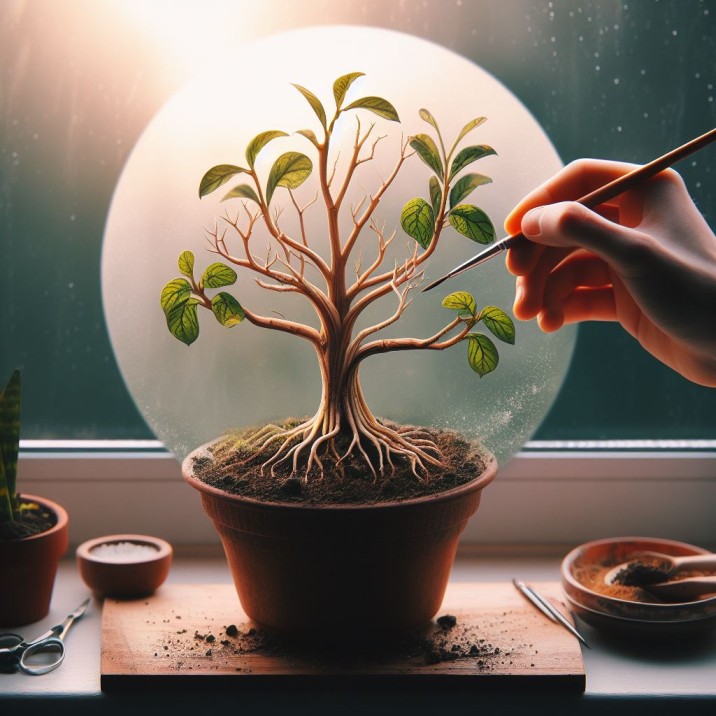
Several soil-borne pathogens, including the species Rhizoctonia and Phytophthora, are responsible for this illness. If it is not quickly identified and dealt with, it may be very damaging.
Causes of Crown and Stem Rot
Overwatering: Soil that has too much moisture in it might foster the growth of crown and stem rot.
Poor Drainage: Waterlogged soil can result from inadequate drainage in pots or other containers, which encourages the growth of fungi.
Contaminated Soil: Plants in good health might get sick when using contaminated potting soil or recycling diseased soil.
Symptoms of Crown and Stem Rot
Wilting and Yellowing: As the disease spreads, beginning at the base of the plant, leaves may wilt and turn yellow.
Dark Lesions: At the base of the stem or close to the soil line, dark, wet lesions might develop.
Discoloration of the stem: The stem may turn brown or black or become mushy, squishy, or discolored.
Treatment of Crown and Stem Rot
Isolation: To stop the illness from spreading, isolate the sick plant from other plants.
Pruning: Cut diseased tissue off of afflicted stems and leaves using clean cuts.
Improved Repot the plant in soil that drains properly and a container with drainage holes.
Reduce Watering: Modify your watering schedule to prevent waterlogging and keep the right moisture levels.
Fungicides: In severe situations, think about using a fungicide labeled for preventing crown and stem rot and applying it as directed by the manufacturer.
Anthracnose
A variety of indoor plants can be afflicted by the fungal disease anthracnose, which can cause varying degrees of harm.
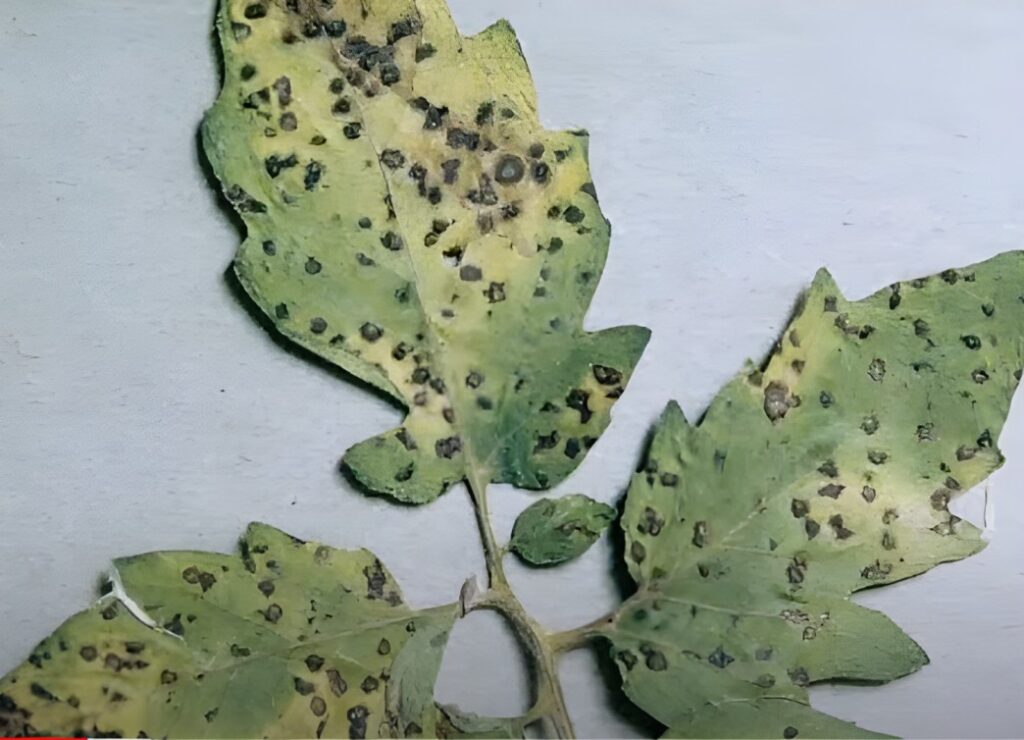
This infection mostly affects the leaves, stems, and even the fruits, causing ugly blemishes and even harming the health of the plant as a whole.
Causes of Anthracnose
Anthracnose is generally brought on by fungi from the genus Colletotrichum or the genus Gloeosporium.
Wetness and Humidity: Excessive wetness and excessive levels of humidity foster the growth of anthracnose.
Plant Stress: Weak or stressed plants are more prone to contracting anthracnose.
Symptoms of Anthracnose
On leaves stems, and fruits, anthracnose appears as tiny, black, and depressed circular lesions.
Blighted Foliage: Yellowing, browning, or wilting are common symptoms of infected leaves, which eventually cause defoliation.
Fruit Rot: Anthracnose can induce fruit rot in plants that grow fruit, making the produce inedible.
Treatment of Anthracnose
Pruning Affected Areas: To stop the illness from spreading, remove and destroy the diseased plant portions.
Enhance Air Circulation: Make sure there is adequate air movement around the plants to lower humidity and moisture levels and so create an unfavorable environment for the growth of fungus.
Fungicidal Treatment: Use an appropriate fungicide in accordance with the directions on the product label to slow the spread of the illness. Maintain correct plant care procedures, such as routine watering, to encourage plant vigor and resistance to anthracnose.
Fungal Leaf Spot
A typical indoor plant disease called fungal leaf spot is brought on by several fungi. Small, spherical, or atypically shaped spots will appear on the leaves of the susceptible plants.
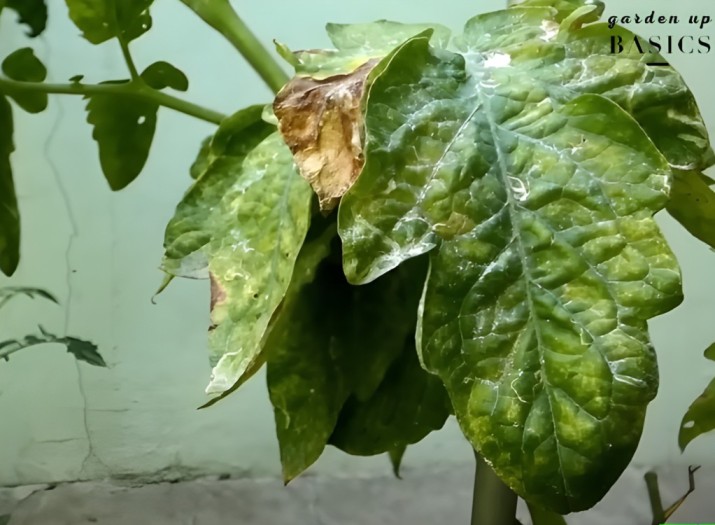
These dots may have a darker border and come in a variety of colors, such as brown, black, or grey. If left untreated, fungal leaf spots can be unattractive and harm the plants that are afflicted.
Causes of Fungal Leaf Spot
Conditions: When it’s humid outside, fungi love to grow on the leaves of indoor plants.
Watering from Above Watering plants from above can splatter water onto the leaves, leaving a wet surface that is ideal for the growth of fungi.
Packed Planting: Plant arrangements that are too packed inside can restrict airflow, creating a micro environment that is conducive to fungi diseases.
Symptoms of Fungal Leaf Spot
Small, rounded or atypically shaped patches on plant leaves are known as circular spots.
Spots might have a darker border and seem brown, black, or grey.
Yellowing of the foliage: Infected leaves may become yellow and then finally fall off the plant.
Treatment of Fungal Leaf Spot
Pruning: To stop the illness from spreading, remove and throw away affected leaves.
Improved Air Circulation: To encourage air circulation, space plants properly.
Water management: Water the soil at the plant’s base to keep the leaves moist rather than watering it from above.
Fungicides: To manage the fungus infection, use an appropriate fungicide in accordance with the manufacturer’s recommendations.
Maintain the ideal humidity levels for indoor plants, and if the humidity is regularly excessive, lower it.
Southern Blight
Sclerotium rolfsii, sometimes referred to as southern blight, is a fungus that can afflict indoor plants.
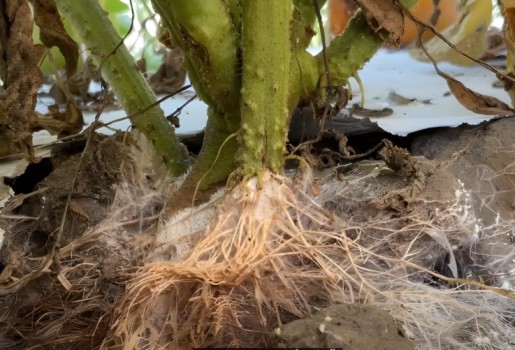
This virus is especially well-known for its capacity to spread quickly and infect a variety of plant types.
In order to save their cherished plants, indoor gardeners must be cautious in spotting and controlling this illness.
Causes of Southern Blight
Fungal Pathogen: Sclerotium rolfsii, a soil-borne fungus, is the culprit behind Southern blight.
Warm and Humid Environments: This illness thrives in warm and humid surroundings, making indoor settings with inadequate ventilation more common.
A higher risk of infection exists in polluted soil or plant debris because the fungus may survive there.
Symptoms of Southern Blight
White Mycelial Growth: White, thread-like mycelium forms on the base of the stem and soil surface.
Brown Lesions: Brown lesions or cankers appear on plant stems close to the soil line.
Rapid Wilt and Death: Infected plants frequently die after experiencing rapid wilting.
Treatment of Southern Blight
Remove and separate contaminated plants to stop the illness from spreading to healthy ones. separate Affected Plants.
Improve Drainage: To create a climate less hospitable to the fungus, provide well-draining soil and abstain from over watering.
Fungicides: As a preventative step or early treatment, use the proper fungicides as directed by the manufacturer.
Remove Infested Soil: If at all feasible, remove the top layer of soil from the infected pots and replace it.
Keep Your Environment Sanitary: To stop the spread of the illness, thoroughly clean and sterilize gardening implements and containers.
Rotate your crops to prevent planting sensitive species in the same soil for a lengthy period of time if you’re growing numerous plants
Understanding and Managing Indoor Plant Diseases and Pests
Indoor plant enthusiasts often encounter a range of challenges, including indoor plant diseases and pests. These issues can be a real concern for plant lovers. Fortunately, there are valuable resources available to help them navigate these problems.
From informative books on indoor plant diseases to comprehensive charts that aid in disease identification, a wealth of information is accessible to both beginners and seasoned gardeners. Online databases and scholarly articles on platforms like Google Scholar and dedicated plant disease journals further contribute to the knowledge base, offering insights into indoor plant diseases management.
Additionally, online quizzes and videos provide engaging ways to learn about common indoor plant diseases and their treatment. In some cases, these plant problems can feel like a veritable “zombie” invasion, but with the right information and resources, enthusiasts can effectively combat these challenges.
Combatting Indoor Plant Pests: Identification and Remediation
House plants, while charming additions to any indoor space, are not immune to pests either. Identifying and addressing indoor plant pests is crucial for maintaining healthy foliage. Whether it’s dealing with voracious pests that devour leaves or contending with tiny invaders like thrips, knowing the enemy is half the battle.
Resources like pest identification apps can be invaluable tools in this regard, offering assistance in pinpointing the culprits responsible for the damage. Whiteflies, web-spinning mites, and stubborn worms are among the many indoor plant pests that can wreak havoc.
Thankfully, dedicated gardeners have shared their experiences and images online, helping others recognize and address these issues. With access to a wealth of information and the right tools, indoor plant lovers can foster thriving greenery while minimizing the impact of diseases and pests on their beloved houseplants.
Conclusion
In conclusion, illnesses that affect indoor plants can seriously hamper the health and attractiveness of plants. Powdery mildew, root rot, bacterial leaf spot, or any of the other prevalent diseases mentioned may all be prevented with prompt detection and the right management.
In order to ensure the well-being of indoor plants and the pleasure of a bright and healthy indoor garden, proper plant care procedures, such as constant monitoring, adequate cleanliness, and efficient treatment methods, may help prevent, manage, and reduce these illnesses.
FAQs
What is the most apparent symptom of powdery mildew in indoor plants?
The development of white, powdery patches on the surfaces of leaves, stems, and even flowers is the most obvious sign of powdery mildew in indoor plants.
What are the common causes of root rot in indoor plants?
Root rot in indoor plants is frequently brought on by overwatering, inadequate drainage, and the addition of contaminated soil or plant debris.
How can you identify bacterial leaf spots in indoor plants?
In indoor plants, bacterial leaf spot often appears as tiny, wet, dark brown or black dots on the leaves, frequently encircled by yellow haloes.
What causes sooty mold on indoor plants, and what is its impact?
Aphids, scale insects, or mealybugs, which produce honeydew, can create sooty mold on indoor plants. Although it doesn’t directly hurt the plant, it can prevent photosynthesis and have an impact on how the plant looks.
What are the common causes of white mold in indoor plants, and how can it be treated?
Overwatering, poor air circulation, and high humidity all contribute to the growth of white mold on indoor plants. You should isolate sick plants, lower humidity, trim afflicted areas, use fungicides, and maintain the right plant spacing in order to treat it.

